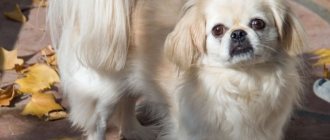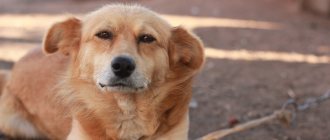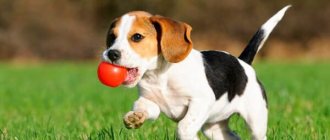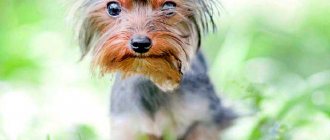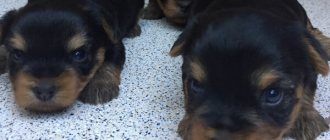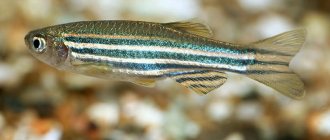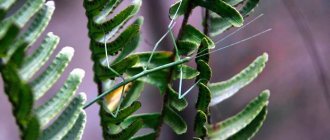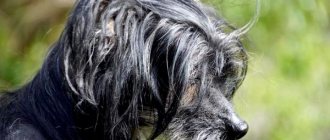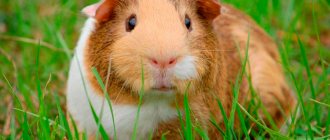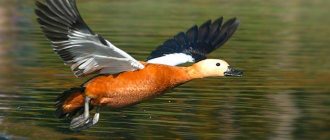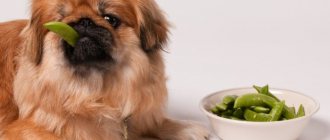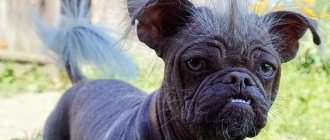The Pekingese is a small indoor dog bred in China and until the 18th century was considered the pet exclusively of emperors and their entourage .
In the 18th century, the breed was exported by the British outside the country and began to gain popularity in Europe.
The Pekingese is famous for its independent and capricious character , but with proper upbringing, it is an intelligent and kind creature to everyone around it. Pekingese dogs do not like fuss , but they value routine and leisurely activities.
It’s worth mentioning separately about the coat - these dogs have long, thick hair with a soft undercoat that prevents them from freezing in the coldest weather, so walking in winter (as well as in summer) is carried out without overalls.
Pekingese puppies
The breed is very unique. Its representatives have luxurious fur. Adult dogs look a little like lions due to the long mane on the neck and head. Pekingese puppies, photos of which can be found on the Internet, differ from adults. They do not have a pronounced mane, soft, long hair that covers the entire body of the animal. The babies look like a fluffy soft toy. A distinctive feature of a decorative dog is dark hair on its face.
A newborn Pekingese weighs only 150-250 grams. By 12 months, the pet grows to 3.5-5.5 kg. An adult dog has the same weight.
Pekingese puppies have a cheerful disposition. They love children immensely and do not refuse games and pranks. At an early age, dogs are curious, active, and naughty. In this regard, it is not recommended to delay education and training. These animals are brave, they adore their owners, and are always ready to help. If a loved one is in danger, the puppy, without hesitation, will rush to attack the enemy.
Pets do not accept cruelty from their owners. They have a very good memory. If the owner offends his four-legged friend, the Pekingese will stop trusting the person for life.
History of the origin of the breed
The origin of the Pekingese is evidenced by the name of the breed - in English it means “Peking”, from where these dogs were brought to England. It is believed that the breed first appeared close to 2000 years ago. However, it became widespread only towards the end of the 19th century, when it was taken out after the capture of the Summer Palace in 1860. Until this time, only the Emperor of China and members of his family had the right to own Pekingese.
Pekingese has always been a popular breed of dog, such a puppy is the cherished dream of many
Where to buy a Pekingese puppy?
The answer to the question “where to buy a Pekingese puppy?” not as simple as it seems. People often pay a lot of money for a small, fluffy puppy, mistaking it for a purebred Pekingese. Typically, such transactions are made after an advertisement is seen in a newspaper or on the Internet. As a result, over time it becomes clear that the pet only vaguely resembles a representative of the Pekingese breed.
Experts advise buying purebred Pekingese from specialized nurseries. There you can get all the necessary certificates, documents for the puppy and parents. Dogs in kennels where breeding is carried out are vaccinated and dewormed.
Kennels sell puppies belonging to a certain category. For example, there is a category “champion” (also called “show class”). Pekingese, which belong to the “champion” category, have practically no flaws. They are very obedient, they have an excellent appearance, and they also take first places in exhibitions. The “breeding class” category means that the pets are excellent for breeding, but do not participate in exhibitions. The third category is “home” or “pet class”. These puppies are not suitable for showing or breeding.
Dogs sold by private individuals through newspapers and the Internet are most often phenotypic. The babies have no pedigree, they only look like a real Pekingese.
There are several recommendations that should be followed when purchasing a real representative of the breed:
- You need to purchase a dog from experienced breeders or kennels.
- The baby must be more than two months old.
- A healthy Pekingese does not limp.
- When purchasing, an agreement is drawn up, which spells out the responsibilities of the seller and the buyer.
- If a puppy is purchased to participate in exhibitions, then its new owner needs to obtain a guarantee from the kennel.
- You can find out whether a dog belongs to the “show class” only after it turns 6 months old. Until this age, it is impossible to guarantee that a dog belongs to the “champion” category.
Listed below are the most famous Russian nurseries where you can buy a Pekingese puppy.
Eternal love (Nizhny Novgorod)
ZHENJU and Savelina (Novosibirsk)
ELITLAIN (St. Petersburg)
Dream Dee Dals (Moscow)
Perfetto (Penza)
Breed standards
There are several standards - Russian, English, American, and many others. International Common is closest to English. Since the breed has become quite widespread, not everyone adheres to the standards. One strict rule can be distinguished: the animal’s tail should be positioned high, fit tightly to the back, bend slightly and fall to the side.
Recognizable features of this breed are a flattened muzzle and large round eyes.
Pekingese colors
Almost all possible colors are acceptable for the Pekingese, except liver. This breed even has albinos, which do not occur among other dogs. The most notable color options:
- Fawn, red. Classic. Most Pekingese are this color. Many consider it the most successful, due to the fact that it does not fade over time.
- White or black. They are also quite widespread. Especially popular lately.
- But mestizos or black and white are less common. Therefore, they are considered elite among breeders. Owners of such colors receive higher marks at exhibitions; Pekingese of other colors are bred with them.
Candidates for mating are always selected very carefully. The appearance and value of future offspring depends on this.
Candidates for mating are always selected very carefully
Pekingese personality
These animals are quite phlegmatic, calm, and sometimes stubborn. They will prefer a measured pace of life, silence to noise and bustle. They say that Pekingese are capricious, this is explained by the fact that for centuries they belonged to members of the imperial family and were spoiled. At the same time, they are very sensitive. Pekingese are good at sensing a person's mood and do not impose themselves when the person is tired or not in the mood. At more appropriate times, these dogs, on the contrary, are very active. They show kindness to strangers. In relation to other dogs they can be bold to the point of recklessness.
Pekingese photo
The Pekingese breed, color options and haircuts can be found in the photos of the puppies.
Lifespan
The average lifespan of a Pekingese is 13-15 years. But among animals that have received proper care throughout their lives, there are long-livers, living 14-20 years.
How much does a Pekingese puppy cost?
The cost can vary from 4 to 50 thousand rubles. The price depends on the category of the animal. Its pedigree and external characteristics are also taken into account. A phenotypical pet will cost approximately 4-10 thousand rubles. You can buy a pet-class Pekingese puppy for 10-15 thousand rubles, a breed-class puppy for 15-30 thousand. Show class Pekingese puppy. Its price varies from 30 thousand rubles and above.
Unusual representatives of the breed are in greatest demand these days, including:
- White Pekingese puppies. Completely white individuals, in which the absence of the characteristic dark pigmentation on the face is acceptable.
- Dwarf Pekingese puppies. Identifying a Dwarf Pekingese puppy is quite difficult. They are born from normal Pekingese dogs. At the same time the same size as the others. Only after 8-9 months do breeders realize that the baby is a dwarf. The weight of such an adult does not exceed 3 kilograms.
- Royal Pekingese. Puppies of this species are the best in the litter of regular Pekingese. The Royal Pekingese is a man-made breed. However, this does not prevent breeders from asking for a higher price for it.
The listed animals have prices higher than other Pekingese by 6-10 thousand rubles.
How to toilet train?
Given the innate stubbornness of the Pekingese, babies should be toilet trained exclusively through interest and encouragement. In the beginning, you should use a diaper or tray with filler.
From the first days of your dog's stay in the house, you should show him the place where he needs to defecate. At the initial stage, you can use several diapers or trays and place them in those places where the puppy most often does his business. He should have a clear association with the litter box and emptying. After a while he himself will look for it.
The second stage is toilet training outside. You can do this from the very first walks. To do this, you need to walk with the baby until he goes to the toilet, and then praise him and treat him with a treat. The goal is to reinforce in the dog’s mind that defecating on the street is associated with positive emotions.
Basic care for a Pekingese puppy
If your four-legged friend has all the necessary things, caring for him will not be difficult. How to care for a Pekingese puppy? First of all, the owner should pay attention to the pet’s fur. She needs to be brushed daily. It is enough to comb the fur of adult dogs three times a week. Daily brushing of babies is done not only to tidy up the coat, but also to accustom the puppy to the procedure itself. The baby should be calm about combing. First, the dog is placed on its back. Then they put him on his paws. Before combing, the wool is sprayed with a special spray. The product will help you get rid of mats easier. It is especially worth paying attention to the armpits and paws. This is where fur often gets stuck.
When taking your dog for a walk, you should treat the fur for fleas. It is also recommended to wear overalls. It keeps you warm and keeps dirt and debris out.
Representatives of this breed are rarely bathed. Only if the puppy is very dirty. After interacting with water, the hair begins to actively fall out and breaks. Dry shampoos are sold for Pekingese. After bathing, it is better to dry the coat with a hairdryer. This is done to prevent the dog from catching a cold.
It is necessary to regularly tidy up your puppy's claws. They are very sharp and grow quickly. If they are not trimmed in time, the baby may injure himself. In addition, the claws become bent and may begin to grow into the paws. If you don't trim them regularly, your dog will end up on the surgeon's table.
Ears are cleaned with dry swabs and only when necessary. If there is an unpleasant smell from the ears, the puppy should be taken to the veterinarian. The smell can signal illness. Another symptom of ear problems is itching. You can learn about it by the behavior of the animal. Usually the baby shakes his head and rubs his ears against objects.
Feeding dry food
Ready-made food has a number of advantages:
- ease of use and storage;
- balanced diet;
- there is a very wide range on the market, allowing you to choose the type for the most picky dog of any age;
- various types of medicinal feeds.
To feed the Pekingese, they choose super-premium and holistic class food.
Feed comparison
The complete composition does not contain grains (they are replaced by potatoes), but is rich in protein (poultry meat). The combination of Omega-3 and Omega-6 is optimal for Pekingese wool. To maintain the health of your dog's joints, it contains chondroitin and glucosamine.
Pro Plan Small & Mini Adult Optidigest
The Pro Plan line includes a wide variety of options. This type (with lamb and rice) is suitable for dogs with sensitive digestion. The product contains corn, which is a common allergen.
Royal farm adult mini chicken
Super-premium complete food that does not contain soy and millet. A special recipe, which contains L-carnitine and a complex of probiotics, allows you to control body weight and prevent the development of obesity.
Bosch mini adult with lamb and rice
The recipe allows small dog breeds to get maximum energy value from a small portion of food. The size and structure of the granules are perfect for Pekingese fangs. Composed of almost 25% protein (poultry) and 18% rice, lamb meal is 5%.
When to change food
The need to change food may arise in the following cases:
- signs of an allergic reaction appeared (scabies, rash, crusts in the ears, diarrhea);
- external signs have appeared indicating a lack of nutrition (hair loss or dullness, layered and breaking claws, plaque on the teeth);
- the Pekingese shows signs of excess weight;
- the age of the dog and its condition (pregnancy, illness) change.
The introduction of a new type of food should occur gradually. You should strictly monitor the dog’s body’s reaction to a new type of food.
Personal items
A small pet should have its own things. Among which are several bowls for water and food. It is best to buy durable metal plates. An equipped bed is required. It is best to place it in a corner from which the dog can clearly see its owners. Special toys from the pet store. You will also need a set of wool brushes, scissors and nail clippers.
A lap dog can't go for a walk without a pair of overalls. Clothing performs several functions at once. Keeps your pet from freezing and also protects its thick coat from dirt.
Care for intimate areas
Attention should be paid to the fold under the nose. This is an integral feature of this breed. It must not be contaminated. This may lead to the development of a skin disease. It is wiped with dry gauze every day.
Owners should monitor the puppy's eyes. Healthy visual organs are clean and clear. A breed specific feature is eye leakage. This is not a disease. It’s just that in some individuals the functioning of the lacrimal duct exceeds the norm. If your dog has tears, they need to be wiped with a dry cloth. Periodically, the muzzle is washed with water and then wiped dry.
The Pekingese is a small dog that cannot reach the anal gland area. The owners will have to wash this delicate area. This is done as needed. About once a month. If the puppy rides on the floor on its hind legs. It also rubs its intimate area on the floor and carpets, which means it needs cleaning. Some owners may think that their pet has worms. However, after cleaning the glands, the itching stops. The animal begins to behave as usual.
Pregnancy and birth
Pregnancy in these small dogs lasts from 55 to 67 days , and 2-3 puppies are born the first time 4-7 babies are possible .
If the process of giving birth to puppies is going normally, then your help to the dog will include carefully releasing the newborn baby from the film, checking his breathing, treating the baby’s umbilical cord with iodine or brilliant green, and vigorously rubbing him so that he can start to speak.
Advice! You should carefully monitor the process of childbirth in a dog, read additional literature on this topic and consult with a veterinarian. If the dog cannot give birth on its own, call a doctor.
You need to rub the puppy with soft, dry flannel or cotton cloths, but remember that this must be done softly and gently. After this, he is placed next to the mother, where he usually immediately finds her nipple. If the baby cannot do this, help him.
Watch carefully when he falls asleep (in a few minutes), then put the puppy in a basket with soft diapers not far from the mother so that she can see the baby. After this, the dog will begin to produce other puppies, with which you need to do the same.
Of course, if this is not the first time a Pekingese mother gives birth, she will cope with everything herself, but if you see that the dog does not immediately understand what to do when the puppy is born, provide all possible help.
A haircut
The first haircut of a Pekingese puppy is carried out when the owners decide. There are no exact rules on this issue. A puppy can be cut at six months, or later. A well-groomed, trimmed dog looks cute. But besides this, it’s more comfortable for him to play and run. The only recommendation from experts is that haircuts are usually carried out twice a year. In addition, owners should try to refine their pet’s coat in spring and summer. That is, in the warm season.
You can trim your pet yourself using a clipper. Or you can visit a special groomer. Before grooming a puppy, its coat must be washed, dried, and tangles removed. It is not recommended to cut your dog's hair. Acceptable haircut options, they are also the most popular:
- “Under the puppy” (about 2-3 centimeters of fur are left).
- “Like a lion” (a beautiful mane is left, the body is trimmed, the length of the ennobled fur is about 1.5 centimeters).
- Hygienic haircut. The fur is only slightly shortened. The main thing is to trim it on the face, panties, and skirt.
Socialization (4-12 weeks)
The dog begins to master social behavior skills. All physiologically important functions are formed, but the baby continues to actively grow.
By the end of the 5th week, the puppy begins a gradual weaning from its mother, which ends at 7-10 weeks. The dog's weight increases to 1.5-2 kg. His first teeth erupt, he begins to taste solid food, gnaw on objects and bite. Physical activity increases sharply.
The Pekingese develops its character, develops reactions to potential danger, and begins to actively communicate and learn about the world around it.
Play activity plays an important role in the development of a dog’s mental activity. Games can be single or group. During play activities, the puppy’s motor skills develop and social behavior is formed.
This stage is dangerous due to physical and mental injuries. Therefore, the dog cannot be punished, but on the contrary, communicate more and teach it to communicate with a person (video author Irina Kuzmina).
What to feed a Pekingese puppy?
Pygmy lion puppies are picky eaters. They need a balanced diet. You can also buy ready-made special food for the puppy, or you can feed it food prepared by the owners. Your baby's diet should contain the foods listed below.
- Dairy products.
- Boiled fish (bones removed first).
- Veal, turkey, beef, chicken.
- Hercules, rice porridge, buckwheat.
Kennels sell puppies over two months old. By this time, the dog has been weaned off its mother's milk. Babies up to three months are fed 6 times a day. From 4 to 6 months, dogs are given food 4 times a day. After six months, the Pekingese should receive food 3 times a day. When the dog turns 10 months old, it is switched to two meals a day.
Vaccination
Caring for a Pekingese puppy involves timely vaccination. The first vaccinations for Pekingese puppies are given at 2 months after the dog stops feeding on mother's milk. Preparation for vaccination involves treating the animal for worms.
After 3 weeks, the puppy should be brought back to the veterinarian for vaccination. This is followed by 2 weeks of quarantine. If they are successful, the dog will not be bothered by anything. On this basis, the doctor will allow you to take your four-legged friend for a walk. The next vaccination is scheduled for the time when the dog's baby teeth are replaced. This will happen by 9-10 months.
Vaccination is necessary for the Pekingese breed. Vaccinations for puppies are best done on time and from trusted doctors. This procedure will protect the animal from many diseases.
Pekingese puppies are quite capricious animals. But they love their owners very much. The pet responds especially well to affection, love, and attention. In addition, a person must provide proper care for the Pekingese puppy. Thanks to kind attitude and proper care, your four-legged friend will be healthy and happy.
